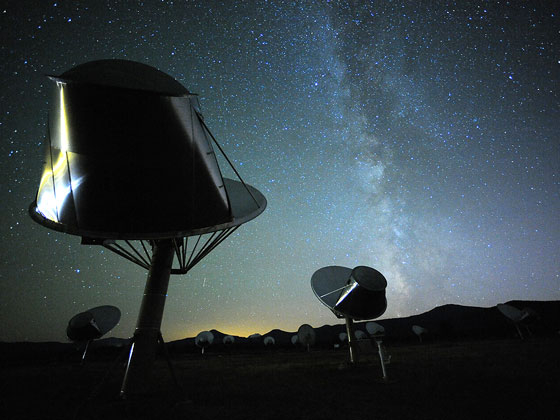
The search for intelligent aliens has expanded to include thousands of star systems very different from that of Earth.
Scientists with the SETI (Search for Extraterrestrial Intelligence) Institute in Mountain View, California have just begun a two-year hunt for signs of alien civilizations around 20,000 red dwarfs — stars considerably smaller and dimmer than Earth's sun.
Red dwarfs are promising targets for SETI scientists. They are the most common stars in the Milky Way, making up about 75 percent of the galaxy's stellar population. And because red dwarfs burn through their fuel slowly, they live a long time; on average, the Milky Way's red dwarfs are billions of years older than the sun, researchers said. [13 Ways to Contact Intelligent Aliens]

"This may be one instance in which older is better," SETI Institute astronomer Seth Shostak said in a statement. "Older solar systems have had more time to produce intelligent species."
Despite these characteristics, however, SETI hunts to date have focused primarily on sunlike stars, for several reasons. For one thing, the one example of life that scientists know about resides in such a system.
In addition, red dwarfs possess relatively narrow "habitable zones" — the range of distances from a star at which liquid water can exist on a world's surface. Furthermore, any planets in a red dwarf's habitable zone would be quite close to the star, and would therefore likely be tidally locked, showing just one face to the star (as the moon shows just one face to Earth). Tidally locked planets are probably roasting-hot on one on side and freezing-cold on the other, making them unlikely candidates to support life, the thinking went.
The new hunt will employ the SETI Institute's Allen Telescope Array (ATA), a system of 42 radio dishes in northern California. The ATA will scan 20,000 red dwarfs that will be chosen from a list of 70,000 such stars compiled by Boston University astronomer Andrew West, SETI Institute scientists said. Relevant data gathered by NASA's Transiting Exoplanet Survey Satellite (TESS), which is scheduled to launch next year, will be incorporated as well, they added.
Get the Space.com Newsletter
Breaking space news, the latest updates on rocket launches, skywatching events and more!
“We’ll scrutinize targeted systems over several frequency bands between 1 and 10 GHz [gigahertz]," SETI Institute scientist Gerry Harp said in the same statement. "Roughly half of those bands will be at so-called 'magic frequencies' – places on the radio dial that are directly related to basic mathematical constants. It's reasonable to speculate that extraterrestrials trying to attract attention might generate signals at such special frequencies."
Follow Mike Wall on Twitter @michaeldwall and Google+. Follow us @Spacedotcom, Facebook or Google+. Originally published on Space.com.
Join our Space Forums to keep talking space on the latest missions, night sky and more! And if you have a news tip, correction or comment, let us know at: community@space.com.

Michael Wall is a Senior Space Writer with Space.com and joined the team in 2010. He primarily covers exoplanets, spaceflight and military space, but has been known to dabble in the space art beat. His book about the search for alien life, "Out There," was published on Nov. 13, 2018. Before becoming a science writer, Michael worked as a herpetologist and wildlife biologist. He has a Ph.D. in evolutionary biology from the University of Sydney, Australia, a bachelor's degree from the University of Arizona, and a graduate certificate in science writing from the University of California, Santa Cruz. To find out what his latest project is, you can follow Michael on Twitter.









